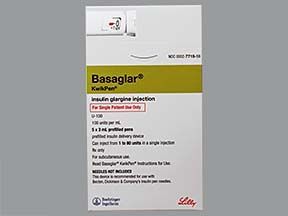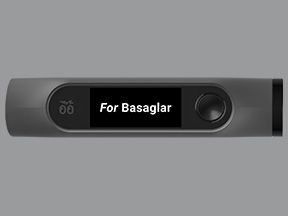Basaglar (insulin glargine) is a brand-name drug that’s used to help manage blood sugar levels in certain people. The drug comes as a liquid solution that’s injected under your skin. It’s usually given once per day.
Basaglar is used to lower blood sugar levels in:
- adults and some children who have type 1 diabetes
- adults who have type 2 diabetes
The active ingredient in Basaglar is insulin glargine. Basaglar belongs to a group of drugs called long-acting insulins.
This article describes the dosages of Basaglar, as well as its forms, strength, and how to use it. To learn more about Basaglar, see this in-depth article.
Below is information about usual dosages of Basaglar, as well as its forms and strengths.
What are the forms of Basaglar?
Basaglar is available as a solution that is injected under your skin. It’s available in a single-use KwikPen and a single-use Tempo Pen. The Tempo Pen can connect to your smartphone and help you keep track of your insulin doses.
What strength does Basaglar come in?
Basaglar is available as a 100 units/milliliter (mL) solution. Both the KwikPen and the Tempo Pen have 3 mL of solution in them, or 300 units total.
What are the typical dosages of Basaglar?
Typically, your doctor will start by prescribing a low dosage. Then they’ll adjust it over time to reach the right amount for you. In the end, your doctor will prescribe the lowest dosage that effectively treats your condition.
The information below describes dosages that are commonly used or recommended. But be sure to take the dosage that your doctor prescribes for you. Your doctor will determine the best dosage to fit your needs.
Dosage for type 1 diabetes
If you’re just starting Basaglar treatment for type 1 diabetes, your doctor will calculate your dosage for you. This will be based on your body weight. In most cases, your starting dose will be about one-third of your total daily insulin requirements.
You’ll likely use Basaglar along with a short-acting insulin. This will make up the rest of your total daily insulin dose. You should inject your dose of Basaglar once daily, at the same time each day.
According to the American Diabetes Association, your total daily insulin requirements will usually be from 0.4 units/kilogram (kg) to 1 unit/kg each day. So, for a person weighing 100 kg, or about 220 pounds (lb), the daily dosage of insulin would likely be 40 units to 100 units per day. Since one-third of this would be long-acting insulin, such as Basaglar, their dosage of Basaglar may be 13 units to 33 units once daily.
Below is a dosing chart with this information:
| Body weight | Total daily insulin dosing range | Basaglar daily dose |
|---|---|---|
| 100 kg (about 220 lb) | 40 units to 100 units | 13 units to 33 units |
Since insulin dosing is very personalized, you should talk with your doctor about the best dosage for you. They’ll help determine it based on your diet, exercise level, and other medical conditions. If there are changes to your insulin routine, your doctor may require you to have your blood sugar level checked more often.
If you’re switching from another insulin medication to Basaglar, your doctor can calculate the best dosage for you. Be sure to tell your doctor about any changes to your diet or exercise level. And be sure to let them know if you develop any other medical conditions. Your dosage of Basaglar may need to be changed, based on these factors.
Dosage for type 2 diabetes
If you’re just starting Basaglar treatment for your type 2 diabetes, your doctor will calculate your starting dose for you. This will be based on your body weight.
You’ll likely start with 0.2 units/kg each day. The maximum dosage of Basaglar for people with type 2 diabetes is 10 units once daily. So, for example, if you weigh 50 kg (about 110 lb), your dosage would be 10 units of Basaglar each day. You should inject your dose once daily, at the same time each day.
Your doctor may adjust your dosage throughout your treatment, based on how well the medication is working for you. Insulin dosing is very personalized and can vary, depending on many factors. These include your diet, exercise level, and other medical conditions you have.
If you’re switching from another insulin medication to Basaglar, your doctor can calculate the best dosage for you. Be sure to tell your doctor about any changes to your diet or exercise level. And be sure to let them know if you develop any other medical conditions. Your dosage of Basaglar may need to be changed, based on these factors.
What’s the dosage of Basaglar for children?
Basaglar is used to treat type 1 diabetes in children ages 6 years and older.
The dosing of Basaglar in children with type 1 diabetes is determined by their body weight (the same as in adults). If your child is just starting Basaglar treatment, the doctor will calculate their dosage.
In most cases, your child’s starting dose will be about one-third of their total daily insulin dose. Your child will likely use Basaglar along with a short-acting insulin. This will make up the rest of their total daily insulin dose. You or your child should inject their dose of Basaglar once daily, at about the same time each day.
According to the American Diabetes Association, the total daily insulin dosage is usually from 0.4 units/kg to 1 unit/kg each day. So, for a child weighing 20 kg, which is about 44 lb, their daily dosage of insulin would likely be 8 units to 20 units per day. Since one-third of this would be long-acting insulin, such as Basaglar, their dosage of Basaglar may be 2 units to 7 units once daily.
Below is a dosing chart with this information:
| Body weight | Total daily insulin dosing range | Basaglar daily dose |
|---|---|---|
| 20 kg (about 44 lb) | 8 units to 20 units | 2 units to 7 units |
But insulin dosing is very personalized, so talk with the doctor about the best dosage for your child. They’ll help determine your child’s dosage based on their diet, exercise level, and any other medical conditions.
If your child is switching from another insulin medication to Basaglar, the doctor can calculate the best dosage for them. Be sure to tell the doctor if there are any changes to your child’s diet or exercise level. And be sure that they know about any other medical conditions. Your child’s dosage of Basaglar may need to change based on these factors.
Is Basaglar used long term?
Yes, Basaglar is typically a long-term treatment. If you and your doctor decide that Basaglar is safe and effective for you, you’ll likely use it long term.
Dosage adjustments
In some cases, your doctor may need to adjust your dosage of Basaglar. This may happen for many reasons, including if:
- your blood sugar level is still high or becomes too low
- your weight changes
- your diet changes
- your exercise level changes
- you have an acute illness
- your kidney or liver function changes
- you develop other medical conditions
- you start or stop taking other medications that treat your diabetes or may affect your blood sugar
Talk with your doctor if your weight, diet, or exercise routine changes. And be sure that they know about any other medical conditions you have. They may recommend checking your blood sugar more often. Or they may suggest an increase or decrease in your Basaglar dosage, based on your condition.
If you forget to inject your dose of Basaglar, you should do so as soon as you remember. If it’s almost time for your next dose, skip your missed dose and inject your next dose at your usual time. If you missed your dose and aren’t sure what to do, talk with your doctor or pharmacist. But do not use more than one dose of Basaglar per day, unless your doctor recommends it.
If you need help remembering your dose of Basaglar on time, try using a medication reminder. This might involve downloading an app or using an alarm on your phone.
The dosage of Basaglar you’re prescribed may depend on several factors. These include:
- the type and severity of the condition you’re using Basaglar to treat
- your age
- your body weight
- other conditions you may have (see “Dosage adjustments” under “What is Basaglar’s dosage?”)
Basaglar is a solution that is injected under your skin. It should be injected into your stomach area, thigh, or upper shoulder. You should change injection sites each time to avoid side effects of the medication.
Before you get your first prescription of Basaglar, your doctor or pharmacist will show you how to inject it. If you would like to learn more about how to inject your doses of Basaglar, the manufacturer has a video with instructions. There are also step-by-step instructions for both the KwikPen and the Tempo Pen.
Do not use more Basaglar than your doctor prescribes. Doing so can lead to serious side effects.
Symptoms of overdose
These are symptoms of low blood sugar and can include:
What to do in case you use too much Basaglar
Call your doctor right away if you think you’ve used too much Basaglar. You can also call 800-222-1222 to reach America’s Poison Centers, or use its online resource. If you have severe symptoms, call 911 (or your local emergency number) immediately or go to the nearest emergency room.
Q:
If Basaglar isn’t working for me, can my dosage be increased?
AnonymousA:
Your doctor will modify your dosage of Basaglar to fit your specific condition. They’ll also adjust your dosage, based on your blood sugar level and your individual goals.
Talk with your doctor about any changes to your weight, exercise routine, or diet. And let them know about any other health conditions. Because these factors may affect your blood sugar level, you may need to check it more often. Your doctor may then recommend that you change your dosage of Basaglar, based on those results.
Be sure to use Basaglar exactly as prescribed. You should not increase or decrease your dosage of this drug unless your doctor recommends it. If you have questions about changing your dosage of Basaglar, talk with your doctor or pharmacist.
The Healthline Pharmacist TeamAnswers represent the opinions of our medical experts. All content is strictly informational and should not be considered medical advice.Disclaimer: Healthline has made every effort to make certain that all information is factually correct, comprehensive, and up to date. However, this article should not be used as a substitute for the knowledge and expertise of a licensed healthcare professional. You should always consult your doctor or another healthcare professional before taking any medication. The drug information contained herein is subject to change and is not intended to cover all possible uses, directions, precautions, warnings, drug interactions, allergic reactions, or adverse effects. The absence of warnings or other information for a given drug does not indicate that the drug or drug combination is safe, effective, or appropriate for all patients or all specific uses.


